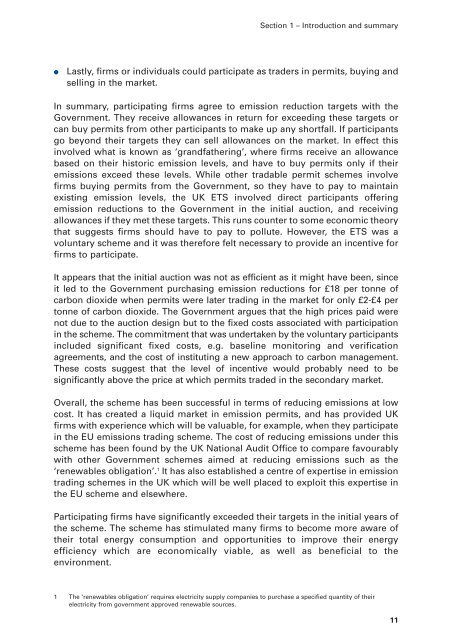Public Policy: Using Market-Based Approaches - Department for ...
Public Policy: Using Market-Based Approaches - Department for ...
Public Policy: Using Market-Based Approaches - Department for ...
Create successful ePaper yourself
Turn your PDF publications into a flip-book with our unique Google optimized e-Paper software.
Section 1 – Introduction and summary<br />
● Lastly, firms or individuals could participate as traders in permits, buying and<br />
selling in the market.<br />
In summary, participating firms agree to emission reduction targets with the<br />
Government. They receive allowances in return <strong>for</strong> exceeding these targets or<br />
can buy permits from other participants to make up any shortfall. If participants<br />
go beyond their targets they can sell allowances on the market. In effect this<br />
involved what is known as ‘grandfathering’, where firms receive an allowance<br />
based on their historic emission levels, and have to buy permits only if their<br />
emissions exceed these levels. While other tradable permit schemes involve<br />
firms buying permits from the Government, so they have to pay to maintain<br />
existing emission levels, the UK ETS involved direct participants offering<br />
emission reductions to the Government in the initial auction, and receiving<br />
allowances if they met these targets. This runs counter to some economic theory<br />
that suggests firms should have to pay to pollute. However, the ETS was a<br />
voluntary scheme and it was there<strong>for</strong>e felt necessary to provide an incentive <strong>for</strong><br />
firms to participate.<br />
It appears that the initial auction was not as efficient as it might have been, since<br />
it led to the Government purchasing emission reductions <strong>for</strong> £18 per tonne of<br />
carbon dioxide when permits were later trading in the market <strong>for</strong> only £2-£4 per<br />
tonne of carbon dioxide. The Government argues that the high prices paid were<br />
not due to the auction design but to the fixed costs associated with participation<br />
in the scheme. The commitment that was undertaken by the voluntary participants<br />
included significant fixed costs, e.g. baseline monitoring and verification<br />
agreements, and the cost of instituting a new approach to carbon management.<br />
These costs suggest that the level of incentive would probably need to be<br />
significantly above the price at which permits traded in the secondary market.<br />
Overall, the scheme has been successful in terms of reducing emissions at low<br />
cost. It has created a liquid market in emission permits, and has provided UK<br />
firms with experience which will be valuable, <strong>for</strong> example, when they participate<br />
in the EU emissions trading scheme. The cost of reducing emissions under this<br />
scheme has been found by the UK National Audit Office to compare favourably<br />
with other Government schemes aimed at reducing emissions such as the<br />
‘renewables obligation’. 1 It has also established a centre of expertise in emission<br />
trading schemes in the UK which will be well placed to exploit this expertise in<br />
the EU scheme and elsewhere.<br />
Participating firms have significantly exceeded their targets in the initial years of<br />
the scheme. The scheme has stimulated many firms to become more aware of<br />
their total energy consumption and opportunities to improve their energy<br />
efficiency which are economically viable, as well as beneficial to the<br />
environment.<br />
1 The ‘renewables obligation’ requires electricity supply companies to purchase a specified quantity of their<br />
electricity from government approved renewable sources.<br />
11
















